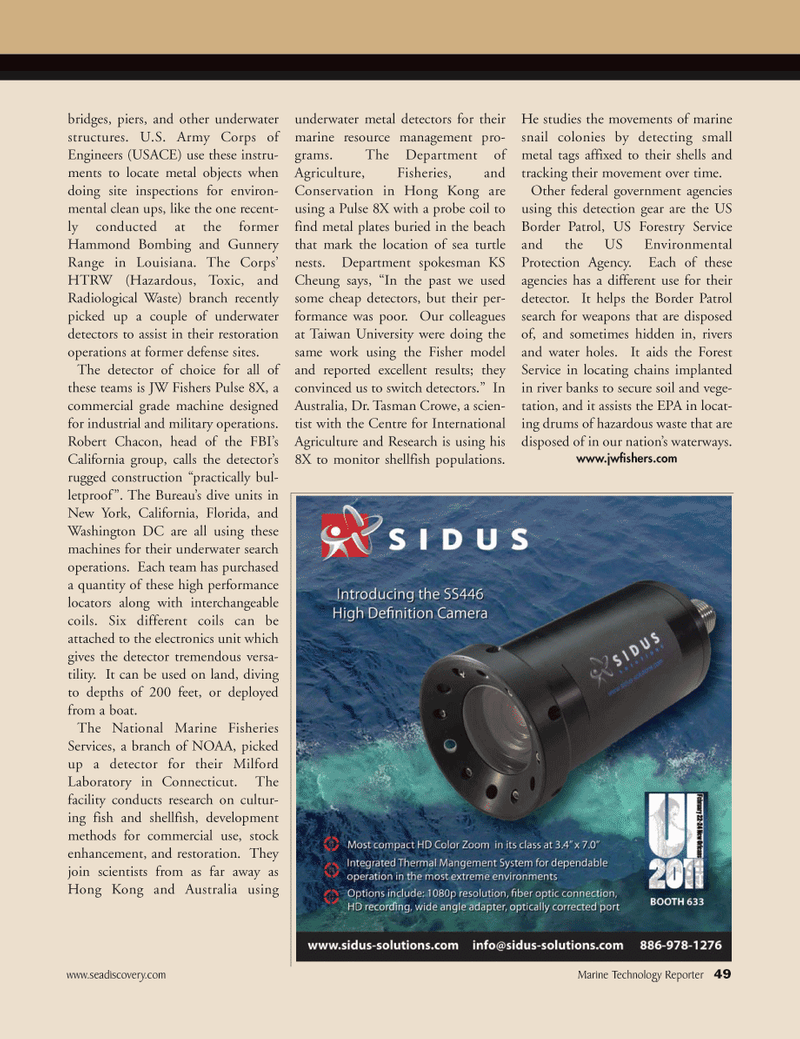
Page 49: of Marine Technology Magazine (January 2011)
Marine Salvage & Recovery
Read this page in Pdf, Flash or Html5 edition of January 2011 Marine Technology Magazine
bridges, piers, and other underwater structures. U.S. Army Corps of
Engineers (USACE) use these instru- ments to locate metal objects when doing site inspections for environ- mental clean ups, like the one recent- ly conducted at the former
Hammond Bombing and Gunnery
Range in Louisiana. The Corps’
HTRW (Hazardous, Toxic, and
Radiological Waste) branch recently picked up a couple of underwater detectors to assist in their restoration operations at former defense sites.
The detector of choice for all of these teams is JW Fishers Pulse 8X, a commercial grade machine designed for industrial and military operations.
Robert Chacon, head of the FBI’s
California group, calls the detector’s rugged construction “practically bul- letproof”. The Bureau’s dive units in
New York, California, Florida, and
Washington DC are all using these machines for their underwater search operations. Each team has purchased a quantity of these high performance locators along with interchangeable coils. Six different coils can be attached to the electronics unit which gives the detector tremendous versa- tility. It can be used on land, diving to depths of 200 feet, or deployed from a boat.
The National Marine Fisheries
Services, a branch of NOAA, picked up a detector for their Milford
Laboratory in Connecticut. The facility conducts research on cultur- ing fish and shellfish, development methods for commercial use, stock enhancement, and restoration. They join scientists from as far away as
Hong Kong and Australia using underwater metal detectors for their marine resource management pro- grams. The Department of
Agriculture, Fisheries, and
Conservation in Hong Kong are using a Pulse 8X with a probe coil to find metal plates buried in the beach that mark the location of sea turtle nests. Department spokesman KS
Cheung says, “In the past we used some cheap detectors, but their per- formance was poor. Our colleagues at Taiwan University were doing the same work using the Fisher model and reported excellent results; they convinced us to switch detectors.” In
Australia, Dr. Tasman Crowe, a scien- tist with the Centre for International
Agriculture and Research is using his 8X to monitor shellfish populations.
He studies the movements of marine snail colonies by detecting small metal tags affixed to their shells and tracking their movement over time.
Other federal government agencies using this detection gear are the US
Border Patrol, US Forestry Service and the US Environmental
Protection Agency. Each of these agencies has a different use for their detector. It helps the Border Patrol search for weapons that are disposed of, and sometimes hidden in, rivers and water holes. It aids the Forest
Service in locating chains implanted in river banks to secure soil and vege- tation, and it assists the EPA in locat- ing drums of hazardous waste that are disposed of in our nation’s waterways. www.jwfishers.com www.seadiscovery.com Marine Technology Reporter 49

 48
48

 50
50
